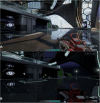A Novel Brain-Computer Interface Virtual Environment for Neurofeedback During Functional MRI
- PMID: 33505237
- PMCID: PMC7830095
- DOI: 10.3389/fnins.2020.593854
A Novel Brain-Computer Interface Virtual Environment for Neurofeedback During Functional MRI
Abstract
Virtual environments (VEs), in the recent years, have become more prevalent in neuroscience. These VEs can offer great flexibility, replicability, and control over the presented stimuli in an immersive setting. With recent developments, it has become feasible to achieve higher-quality visuals and VEs at a reasonable investment. Our aim in this project was to develop and implement a novel real-time functional magnetic resonance imaging (rt-fMRI)-based neurofeedback (NF) training paradigm, taking into account new technological advances that allow us to integrate complex stimuli into a visually updated and engaging VE. We built upon and developed a first-person shooter in which the dynamic change of the VE was the feedback variable in the brain-computer interface (BCI). We designed a study to assess the feasibility of the BCI in creating an immersive VE for NF training. In a randomized single-blinded fMRI-based NF-training session, 24 participants were randomly allocated into one of two groups: active and reduced contingency NF. All participants completed three runs of the shooter-game VE lasting 10 min each. Brain activity in a supplementary motor area region of interest regulated the possible movement speed of the player's avatar and thus increased the reward probability. The gaming performance revealed that the participants were able to actively engage in game tasks and improve across sessions. All 24 participants reported being able to successfully employ NF strategies during the training while performing in-game tasks with significantly higher perceived NF control ratings in the NF group. Spectral analysis showed significant differential effects on brain activity between the groups. Connectivity analysis revealed significant differences, showing a lowered connectivity in the NF group compared to the reduced contingency-NF group. The self-assessment manikin ratings showed an increase in arousal in both groups but failed significance. Arousal has been linked to presence, or feelings of immersion, supporting the VE's objective. Long paradigms, such as NF in MRI settings, can lead to mental fatigue; therefore, VEs can help overcome such limitations. The rewarding achievements from gaming targets can lead to implicit learning of self-regulation and may broaden the scope of NF applications.
Keywords: brain–computer interface; methodology development; neurofeedback (NF); real-time fMRI (rtfMRI); self-regulation; virtual environment (VE).
Copyright © 2021 Baqapuri, Roes, Zvyagintsev, Ramadan, Keller, Roecher, Zweerings, Klasen, Gur and Mathiak.
Conflict of interest statement
The authors declare that the research was conducted in the absence of any commercial or financial relationships that could be construed as a potential conflict of interest.
Figures













Similar articles
-
When the Brain Takes 'BOLD' Steps: Real-Time fMRI Neurofeedback Can Further Enhance the Ability to Gradually Self-regulate Regional Brain Activation.Neuroscience. 2018 May 15;378:71-88. doi: 10.1016/j.neuroscience.2016.09.026. Epub 2016 Sep 19. Neuroscience. 2018. PMID: 27659118 Free PMC article.
-
Mediation analysis of triple networks revealed functional feature of mindfulness from real-time fMRI neurofeedback.Neuroimage. 2019 Jul 15;195:409-432. doi: 10.1016/j.neuroimage.2019.03.066. Epub 2019 Apr 3. Neuroimage. 2019. PMID: 30953836 Clinical Trial.
-
Manipulating cybersickness in virtual reality-based neurofeedback and its effects on training performance.J Neural Eng. 2025 Mar 13;22(2). doi: 10.1088/1741-2552/adbd76. J Neural Eng. 2025. PMID: 40048822
-
A Guide to Literature Informed Decisions in the Design of Real Time fMRI Neurofeedback Studies: A Systematic Review.Front Hum Neurosci. 2020 Feb 25;14:60. doi: 10.3389/fnhum.2020.00060. eCollection 2020. Front Hum Neurosci. 2020. PMID: 32161529 Free PMC article.
-
Real-time fMRI brain computer interfaces: self-regulation of single brain regions to networks.Biol Psychol. 2014 Jan;95:4-20. doi: 10.1016/j.biopsycho.2013.04.010. Epub 2013 May 1. Biol Psychol. 2014. PMID: 23643926 Review.
Cited by
-
Establishing the foundation for technology adoption: profiles of military students in the digital age.Front Psychol. 2025 May 23;16:1593326. doi: 10.3389/fpsyg.2025.1593326. eCollection 2025. Front Psychol. 2025. PMID: 40486891 Free PMC article.
-
Evaluating EEG neurofeedback in sport psychology: a systematic review of RCT studies for insights into mechanisms and performance improvement.Front Psychol. 2024 Jul 19;15:1331997. doi: 10.3389/fpsyg.2024.1331997. eCollection 2024. Front Psychol. 2024. PMID: 39156814 Free PMC article. Review.
-
Applying antagonistic activation pattern to the single-trial classification of mental arithmetic.Heliyon. 2022 Oct 20;8(10):e11102. doi: 10.1016/j.heliyon.2022.e11102. eCollection 2022 Oct. Heliyon. 2022. PMID: 36303917 Free PMC article.
-
A Review of Neurofeedback Training for Improving Sport Performance From the Perspective of User Experience.Front Neurosci. 2021 May 28;15:638369. doi: 10.3389/fnins.2021.638369. eCollection 2021. Front Neurosci. 2021. PMID: 34127921 Free PMC article. Review.
-
Basic stimulus processing alterations from top-down cognitive control in depression drive independent temporal components of multi-echo naturalistic fMRI data.Transl Psychiatry. 2025 May 16;15(1):171. doi: 10.1038/s41398-025-03386-4. Transl Psychiatry. 2025. PMID: 40379640 Free PMC article.
References
LinkOut - more resources
Full Text Sources
Other Literature Sources

